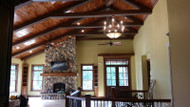
Bold, natural-looking, lightweight, and safe, faux wood beams provide a luxurious level of sophistication in any home or business.
Modern faux wood beams are engineered with a durable weatherproof design and non-toxic framework that enables this type of decorative investment to appreciate on both a long and short term scale.
Types of Faux Beam Materials
In the beginning, faux beams were typically created out of high-density expanding foams, each tested to meet a particular standard for decorative use. Three of the most common types included:
- Urea-Formaldehyde Resins: Simple to manufacture and produce, although it is not waterproof and may quickly show signs of wear.
- Phenol-Formaldehyde Resins: An excellent choice for exterior projects, especially cabins and rustic-style homes. These usually come in yellow or brown colorations.
- Melamine-Formaldehyde Resins: Pale white or grey, this material is heat and water-resistant against even the most extreme conditions.
While each of these foams were uniquely beautiful and accessible, experts do not recommend investing in faux beams that contain elements of formaldehyde. Studies have shown that animals with prolonged exposure to formaldehyde gases can experience severe health defects during their lives. A safer material was needed for decorative faux beams, high-density polyurethane.
Most Common Material for Faux Beams
Today, the most common material that faux beams are made of is high-density polyurethane foam, resistant to damage from light, water, and other extreme weather elements. This is the material that AZ Faux uses to produce its faux beams, mantles, and truss systems.
High-density polyurethane foam is a substance that is forced to expand within a specialized mold over a certain amount of time. The high-pressure environment and overall density of the material create strong and attractive faux wood beams similar to white pine. The specific density of each beam is mandated according to individual manufacturing plants and relevant construction regulations.
Polyurethane is a chemical compound that is used to create a plethora of items for the modern consumer, including:
- Memory Foam
- Wheels for Roller Coaster and Amusement Park Rides
- Construction Sealants and Fire Retardants
- Boat Decks
- Body Armor (Similar to Kevlar)
Strong, non-toxic, and elegant, this styrofoam-like material is unquestionably the best option for use in your personalized decor.
Advantages Of Polyurethane Foam Beams
Although faux wood beams can be made of other materials besides high-density polyurethane foam, there are many advantages to investing in this type of decor.
- Foam beams are extraordinarily lightweight, dramatically reducing installation timelines.
- Faux wood beams are less susceptible to pest infestations and damages incurred from powderpost beetles, carpenter ants, termites, and other wood-eating insects.
- Polyurethane is waterproof, light and heat resistant, and non-toxic to the areas in which they are installed.
- Choosing faux beams helps preserve the environment, and creates a more consistent appearance in the decorating palette.
- Solid wood beams can be expensive and even cost-prohibitive, unlike more accessible and less exclusive polyurethane beams.
The timeless look of the traditional wooden beam is easily recreated with the smarter, clearer, and more efficient faux wood structure of high-density polyurethane foam.
How Heavy Are Faux Wood Beams?
Despite the high-density manufacturing, polyurethane foam beams will not be as heavy nor as unwieldy as real wood materials.
Faux wood beams are up to 15 times lighter than regular wood, requiring only two people to install a 36 lb 6"x6"x20' beam inside a home or business.
Does Faux Wood Expand Or Contract?
High-density polyurethane foam will expand or contract similarly to real wood. However, foam beams have a margin of expansion that is half that of real wooden structures.
Are There Color And Texture Options?
Due to the synthetic material of faux wood beams, color schemes are varied and highly customizable. Some of the most popular faux wood finishes include:
- Sable
- Burnished
- Weathered Gray
- Log
- Espresso Brown
- Pioneer
All colors are paired with a texturized beam style that complements the area’s unique character. The decision to include a rough-hewn pattern or a smooth-sanded finish is entirely up to you. Generally, it is recommended that light colors be used to contrast with dark colors and vice versa.
For the ultimate customization, buy and unfinished beam and finish it yourself.
Are Faux Beam Materials Toxic Or Poisonous?
AZ Faux uses a non-toxic, high-density polyurethane foam, eliminating most concerns regarding airborne chemicals. Cured polyurethane is one of the safest chemical compounds in interior decorating, and is much cheaper and more durable than real wood.
Discover The Perfect Faux Wood Beams For Your Project
With a wide variety of benefits and impeccable decorative appearance, high-density polyurethane beams make the perfect addition to any interior or exterior space.
If you’re ready to begin the process of discovering the perfect faux wood beams for your project, reach out to the experts at AZ Faux Beams by calling one of our architectural consultants today at 888-314-2326. Our professionals are waiting to make all your decorative dreams a reality.